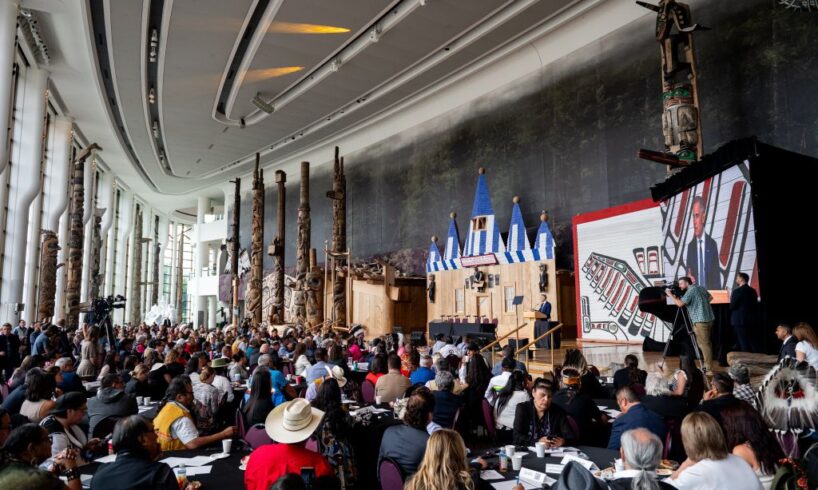
The feedback from the First Nations leadership summit on the federal government’s push to build big projects — first introduced under Bill C-5 — has been almost universally negative. After attending last week’s gathering in Gatineau, Que., Grand Chief Stewart Phillip of the Union of British Columbia Indian Chiefs provided a scathing, albeit representative, summary.
“The sole purpose of Prime Minister Mark Carney’s First Nations summit was to serve notice on Canada’s First Nations that Bill C-5 is now the law of the land,” Phillip said in a statement. “Further, First Nations are now expected to fully accept and accommodate that reality.” Or even more pointedly, Atikameksheng Anishnawbek First Nation Chief Craig Nootchtai called it a “subjugation session — not a consultation session.”
Neither of them were wrong.
I was invited to attend the recent First Nations Major Projects Summit, with the prime minister, which was referred to in emails as simply “First Nations Summit.” It was convened at the request of the Assembly of First Nations in response to the hastily drafted Bill C-5. After being passed with equal haste in June, the bill is now officially known as the Free Trade and Labour Mobility in Canada Act and the Building Canada Act.
Prime Minister Carney passed the act in record speed, though not without significant Indigenous resistance — particularly to the Building Canada Act, which was the focus of the summit. Condemnation of the bill was widespread among First Nations and Indigenous organizations, drawing protests and sparking outrage. Treaty 6 nations called it “an attack on Treaty Rights.”
First Nations Major Projects Summit: sloppy organization and cancelled invites
To address the outrage made clear by many Indigenous communities — and to do damage control — Carney agreed to bring together chiefs from First Nations across the country for a summit on July 17.
It was a tight time frame and it meant the summit was hastily and sloppily organized. I received my invitation on July 4. After I responded to confirm my attendance, I received the detailed conference information on July 9 along with a promise from the Privy Council Office to pay up to $5,000 per person for each First Nation, or First Nation organization’s participation. (I’m a member of Kwantlen First Nation, and spokesperson for our unrecognized democratic council. The federal government only recognizes our hereditary chief and her appointed council, and the matter remains before the courts.) With less than a week to go, I booked my flights and hotel — even before they had sent over the agenda.
But the day before I was due to depart, I received a notice from the organizers cancelling my participation, and apparently reneging on the commitment to reimburse me for my non-refundable flights and hotel.
And I wasn’t the only one. Chiefs of Ontario told the Canadian Press in a statement, “It’s disappointing that technical staff, experts and lawyers from organizations and First Nations who were going to attend this meeting were uninvited after they were allowed to register. They all spent money on travel and accommodations to support chiefs during this critical discussion.”
The guest list itself was also controversial. Lyackson First Nation Hereditary Chief Laxele’wuts’aat Shana Thomas complained during the event that organizers actually asked hereditary chiefs like her not to come — federal workers apparently ignorant of the fact that many B.C. First Nations only have hereditary chiefs and have no elected alternative: “I was told […] it’s only elected chiefs and I just want you to know that not all of our communities follow the Indian Act system,” she told the organizers. “I am a hereditary chief of Lyackson in accordance with our snəw̓eyəɬ, in accordance with our laws.”
These were just the first signs the summit organizers were perhaps not fully prepared for the discussions ahead.
After promising to “look into” the issue with my own invitation, the organizers stopped responding, and so without any clarity, I got on the plane and went to the summit.
‘I don’t believe you’: chiefs made concerns clear to Carney at the summit
When I arrived, I was allowed in, but directed to an overflow room in another part of the venue (coincidentally, one where I once gave a keynote speech). There, I found a few dozen band lawyers, as well as environmental and policy experts. These are the kinds of people chiefs rely on for advice — just like the leaders of other governments do — and they were likely also surprised by the last-minute change in plans. We watched the summit on a large screen, and some of us were able to duck back and forth to the main venue to look at it from a distance. We also had access to Slido, an app that was used to collect queries from chiefs, especially those who were attending remotely.
Like a number of other attendees of Prime Minister Mark Carney’s First Nations Major Projects Summit, author Robert Jago found himself ushered into another part of the summit venue, where he watched the proceedings on a screen. Photo: Supplied by Robert Jago
From the get-go, two themes asserted themselves. The first was the ham-fisted communications style of federal officials and cabinet ministers. The second was the anger and fear being conveyed by First Nations chiefs.
Lawyer and past Assembly of First Nations National Chief Ovide Mercredi got a round of applause, for example, for demanding the prime minister prove tariffs would hurt First Nations, and stating succinctly, “I don’t believe you.”
On the first day, Privy Council deputy clerk Christiane Fox said, “If this is a protest for you, it’s an opportunity for us to listen.” But they spent so much time promising to listen that few First Nations leaders had time to speak at all. By the second day, the moderator had to ask cabinet ministers and members of Parliament to limit comments to no more than two minutes, to give space for First Nations leaders to speak.
Immediately following that request, Mandy Gull-Masty, the federal minister of Indigenous Services (also the first Indigenous person to hold that role), took six minutes to critique opposition to the act, saying, “If we do not take the strategic decision to work together, we could see those tariffs harming Indigenous communities in a very substantive way.”
Mercredi’s statement of disbelief was echoed again and again by the majority of the few First Nations leaders who got the opportunity to speak, including those commenting online.
Those included Chief Angela Levasseur of the Nisichawayasihk Cree Nation, who has been fighting with Indigenous Services Canada to evacuate band members with respiratory issues in the face of wildfires in Manitoba. In the conference app she asked, “Whenever First Nations decide to reject a project of national interest based on their own decisions for their survival, will the prime minister commit to ensuring the state will not use the army or police force against any First Nations across the country?”
It’s a shocking question in that it’s so pertinent. But the fact is there have been too many cases, most recently and notably in Wet’suwet’en country, where First Nations resistance to industrial development was met with force — in that case, by militarized RCMP. She did not receive an answer. In fact, only one online query from First Nations representatives received a reply during the full two-day summit.
One of the summit’s sessions was moderated by the first ever Coast Salish member of Parliament, Wade Grant (caləχʷəlenəxʷ). The Coast Salish people are critically important for Canada’s efforts to expand its oil and gas market to the Pacific, as any pipeline project would need to cross through dozens of Coast Salish reserves in southwestern B.C. But despite the fact that one-third of all First Nations are located in B.C., only a handful of representatives had the chance to ask questions — and none received answers.
Grant was also singled out by Minister of Intergovernmental Affairs Dominic LeBlanc, who made a crack at Grant’s expense at the end of his session. “Conscious that you completely mismanaged the time here Wade, I’m happy to turn it back over to you,” LeBlanc said. “Maybe that’s a mistake.”
While clearly intended as a joke, Grant was the only moderator spoken to in this way, and it struck me as disrespectful. I also saw people around me cringe and look at each other.
Bill C-5 echoes the Harper past
Among those whose online questions weren’t answered was Raymond Cardinal, the Alberta First Nations representative on the Indigenous Advisory and Monitoring Committee for the Trans Mountain pipeline. “I was asked to submit questions based on years of experience,” Cardinal commented after the summit, on a LinkedIn post I made sharing my thoughts. “I was not surprised when they ignored them. … The facilitator played favorites with chiefs in the room.”
It’s notable that Cardinal’s expertise was dismissed, because the prime minister has committed to creating an Indigenous advisory council as the main tool to protect First Nations’ interests within the newly created Major Projects Office. In the words of LeBlanc, “The council’s mandate will be to enhance, collaborate efforts with rightsholders and communities and advance economic partnerships.”
The council was the most widely discussed item during the summit — particularly the ambiguity about how it will be structured and what authority it will have. We don’t know the composition of the council, what representation it will have or how members will be nominated and appointed.
Even Prime Minister Carney seemed confused about how the Indigenous advisory council will operate, telling summit attendees, “How do we go forward from here and once we start the consultation? Because this was not, this was never a consultation. This was not a consultation today. This is engagement. But once we start the consultations, and then once those consultations start to lead to some specific projects, how does that work?”
By the sound of it, the council may be responsible for overseeing federal consultations. But based on statements by the prime minister and other federal representatives, those consultations will be limited, with the bulk of the work done by private companies in advance of applying to the major projects office and being fast-tracked. Privy Council deputy clerk Fox explained that proponents who applied for national interest designation will need to show what consultation work they’ve done, and should come prepared with support letters from affected First Nations governments, and commitments for Indigenous equity partnerships.
Atikameksheng Anishnawbek First Nation Chief Nootchtai provided an Indigenous translation of those commitments, saying, “You say to us, we’re going to come to you, we’re going to consult with you. But again at the end you just delegate your authority to a proponent who then we have to fight with for resources to negotiate with them when they’re given the upper hand.”
As one chief said, there’s no such thing as a consultation after the bill has already been passed. Consultations should include accommodations and should have as their motivating factor the United Nations Declaration on the Rights of Indigenous Peoples (UNDRIP) requirement for free, prior and informed consent — not, like we saw at the summit, a session for First Nations to vent after a decision has already been made without them.
Prime Minister Carney appears not to understand why First Nations leaders were so frustrated by Bill C-5. The fact is, this wasn’t the first bill of this kind, these aren’t the first Native people to complain about it and this isn’t even the first summit convened to mollify us.
The last time something like Bill C-5 was attempted was in 2012, under Conservative Prime Minister Stephen Harper, with Bill C-45. Harper’s bill also aimed to circumvent existing legislation to facilitate major projects on Indigenous territories — and it kicked off the Idle No More movement among First Nations. Idle No More culminated in a 2012 summit with the governor general, cabinet ministers, the Prime Minister and more than 400 chiefs. Among them was Grand Chief Derek Nepinak, head of the Assembly of Manitoba Chiefs, who said: “The summit is only for one day and … First Nations are tired of being trotted out for photo opportunities.”
It was true then, and true now. Chief Nepinak was present last week, this time at Prime Minister Carney’s supposedly unprecedented summit. He summed up the frustration among attendees, saying: “Consultation is going to have to be much more robust than this meeting.”
History may repeat itself, but it is frustrating that the same chiefs have to repeat themselves on the same issues decade after decade. If the prime minister really listened, he would have heard First Nations leaders make one thing clear, above all else: they want the opportunity to consent or reject projects based on the needs of their own voters, and no advisory council, summit or equity shares will accomplish that. Once again, it seems like the only real options for First Nations are protests in the streets and challenges in the courts.





